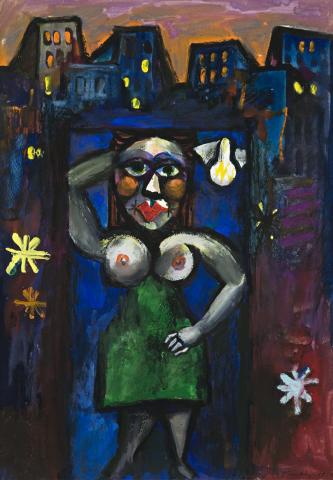WOMAN, 1950
ALBERT TUCKER
gouache, synthetic polymer paint, oil pastel and charcoal on paper
52.5 x 37.5 cm
signed and dated lower right: Tucker 1950
The artist, Melbourne, until 1999
Private collection, Melbourne
Bonhams & Goodman, Melbourne, 7 August 2007, lot 33
Private collection, Sydney
Albert Tucker: Works on Paper 1928–1978, Tolarno Galleries, Melbourne, 25 October – 12 November 1978, cat. 133 (as Woman in Door)
Albert Tucker: An Aspect of His Work, Tolarno Galleries, Melbourne, 3 – 21 July 1990, cat. 26 (as Woman in Doorway)
Meeting a Dream: Albert Tucker in Paris 1948 – 1952, Heide Museum of Modern Art, Melbourne, 18 July – 5 November 2006
Harding, L., Meeting a Dream: Albert Tucker in Paris 1948 – 1952, Heide Museum of Modern Art, Melbourne, 2006, p. 58 (illus.)
Study for (Woman), 1950, Private collection, illus. p. 36 in Harding, L., Meeting a Dream: Albert Tucker in Paris 1948 – 1952, Heide Museum of Modern Art, Melbourne, 2006
Albert Tucker's Woman, 1950 is a painting of enormous power and invention, a fascinating work at this stage of his creative development. Having its genesis in his Images of Modern Evil spawned by the war years of Melbourne in the 1940s, Tucker responded to the traumatic upheavals of society, revealing its darker sides with the tarts of war paraded in the blackouts and primal urges, pierced by the sharp lights of night, of traffic, tram and lamp post. Moving to Europe in 1947, Tucker took this street nightlife imagery with him, representing it on the boulevards of Paris, the Seine, St Denis, or the bomb-wrecked streets of Frankfurt. He was in Paris in 1950 when Woman was painted - brazenly confrontational, heralding other such masterly works to come - The Old Eve, 1951 (National Gallery of Australia, Canberra), and Girl, 1951 (Art Gallery of Ballarat, Victoria). While the influence of the modernist Jean Dubuffet is so apparent in these two paintings, Woman provides a fascinating insight into his work just prior to the Dubuffet onslaught of emotional savagery and kindred technique intertwined.
Works close to Woman, 1950 such as Macro of Place Pigalle, 1949 (National Gallery of Victoria, Melbourne) and Man with Flower, 1950 (The British Museum, London) reveal the earlier, vital influence of Picasso, first touched by art brut. Tucker loved Paris and, no matter their subjects, something of its joys and character spills over into these paintings. 'In a Paris cafe, you could sit there all day, amongst people whom you felt rapport and sympathy with, you could be amongst all that but you were never interfered with. It was a glimpse of civilised life for me.'1
The power of Woman, 1950 owes much to its confronting imagery and colour. The direct look is taken up by bare-bosomed frontalism and the visually rhetorical repetition of forms - unmoving almond eyes, rouged cheeks, scarlet lips of entrapment, bosoms bold, the bare light bulb a metaphor of starkness, light cruel and unforgiving. The femme fatale has become the Medusa of the streets, her look enough to turn any who catch her eyes into stone. The arms manipulative and snaring in their proposed embrace, the enticing doorway encaging the figure. (When exhibited in 1978, it was titled Woman in Door, an emphasis likewise found in the preliminary drawing.) Primary colours take up the heart beat as the passion of the night reflects in the skies above buildings angular, rising vertically from which chrome yellows stare out of darkness like some wild beasts of the jungle speaking of the animalism of it all. The beauty of Paris, the city of love may be prostituted, but its star-like flowers hint at beauty.
1. Albert Tucker quoted in Burke, J., Australian Gothic: A life of Albert Tucker, Knopf, Random House Australia, Sydney, 2002, p. 302
DAVID THOMAS
